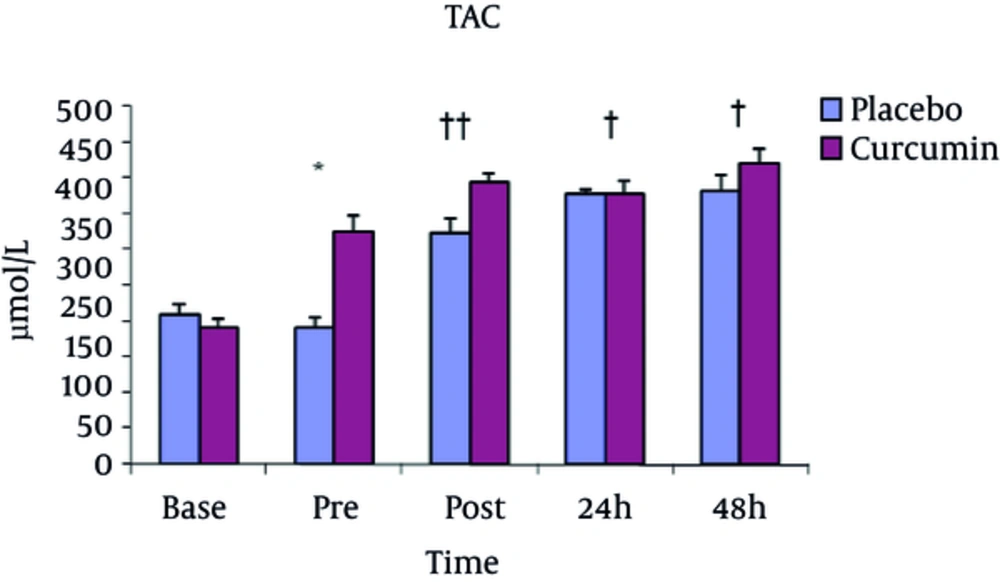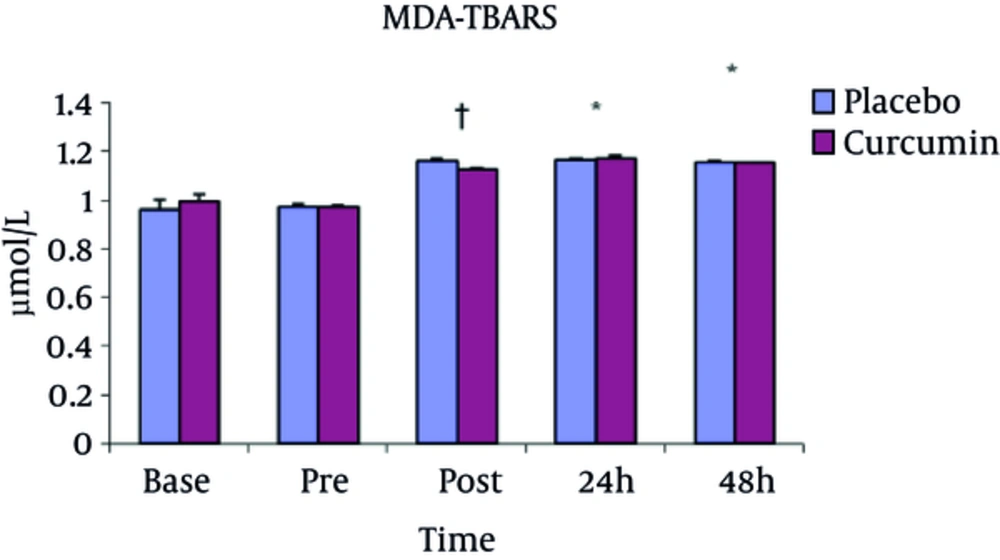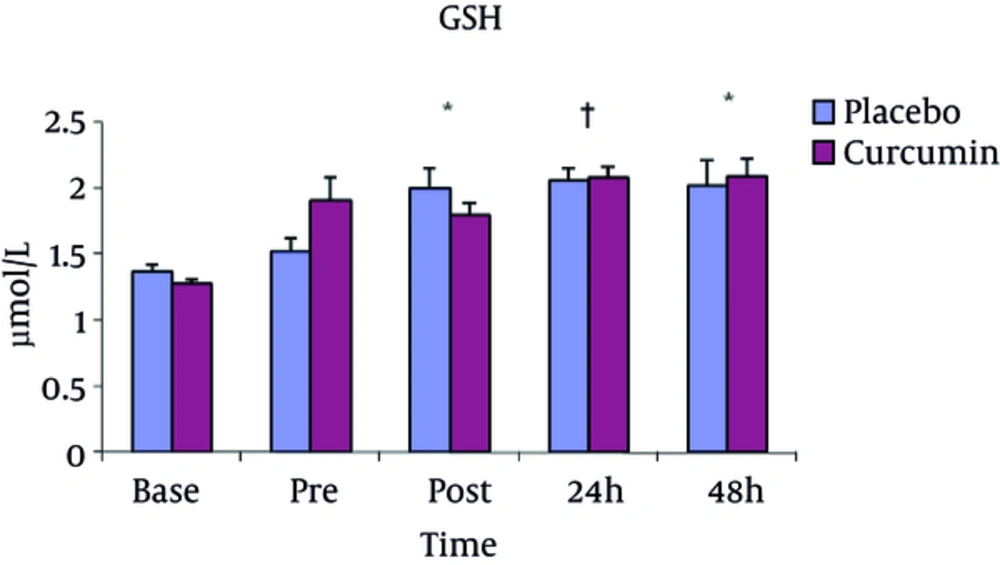1. Background
Due to their molecular instability, in order to become stabilized, reactive species and free radicals promote oxidation reactions with other molecules, such as proteins, lipids, and DNA (1, 2). Oxidative stress as an imbalance between free radical production and the endogenous antioxidant defense system, predominantly results in accumulation of oxidative damage, activation of stress-sensitive signaling pathways and development of pathological conditions such as cardiovascular disease, metabolic syndrome, and insulin resistance (3).
According to the hormesis curve, exercise is able to modulate free radicals (4). On the one hand, reactive species and free radicals serve as stimulating signals of several genes which encode transcription factors, differentiation, and development as well as stimulating cell- cell adhesion, cell signaling, involvement in vasoregulation and fibroblast proliferation, and increased expression of antioxidant enzymes (5). On the other hand, as the other endpoint of the hormesis curve, intensive exercise or overtraining enhances the danger of disease and health hazards (6).
Our body has an elaborate network of antioxidants that act as a defense system neutralizing free radicals and reactive species. This process allows for the maintenance of homeostasis. Nevertheless, oxidative stress and impaired cellular function may occur if there is an increase in the body’s oxidant concentrations, overwhelming the available antioxidants (7). Supplementation with antioxidants may help to attenuate the damage of the body induced by oxidative stress (8). Several studies have reported that supplementation with antioxidants is a good alternative for reducing the damage caused by exercise in athletes or non-athletes (9-12).
Curcumin is a hydroxycinnamic acid derivative and its structure contains two hydrophobic polyphenolic rings with two carbonyl groups. It is the main curcuminoid found in the spice turmeric, a plant alkaloid obtained from the ground rhizome of the perennial herb Curcuma longa. Curcumin is a part of the spice turmeric causing the yellow color of curry, which possesses anticancer, anti-inflammatory, antioxidant, and antibacterial qualities (13). It has been used in the alternative medicine systems of India (Ayurvedic medicine) and Asia (traditional Chinese medicine) to treat gastrointestinal, pulmonary and liver disorders, wounds and sprains (14). Curcumin has been studied for multiple bio-functional activities, including anti-obesity (15), anti-inflammation (16), anti-cancer (17), anti-angiogenesis (18), anti-diabetes (19), hepato-protection (20), radio-protection (21), and chemopreventive activities (22). Recent research has shown curcumin to be a powerful antioxidant and it acts as a scavenger of the superoxide anion, the hydroxyl radical and nitrogen dioxide (23).
In recent years, a plethora of investigations can be observed in relation to the effect of different types of antioxidants on exercise-induced oxidative stress with controversial results. However, there are a few investigations to assess the influence of curcumin supplementation as an antioxidant on exercise-induced oxidative stress in humans. To the best of our knowledge, there is no study about the effect of 7 days supplementation of curcumin on exercise-induced oxidative stress in humans.
2. Objectives
The purpose of this investigation was to assess the influences of one week curcumin supplementation on total antioxidant capacity (TAC), reduced glutathione (GSH) and lipid peroxidation (MDA) following an intensive training session.
3. Methods
3.1. Participants
In this study, twenty-two active, healthy males participated voluntarily. Each subject completed a pre-exercise health readiness questionnaire. The exclusion criteria for this study were: a) having history of surgical or medical procedures that might significantly influence the investigation results, including metabolic, renal, hepatic, cardiovascular or musculoskeletal diseases; b) using medication or being smokers that might have significantly affected the study outcome; c) using any nutritional supplements (i.e. vitamins, amino acids, creatine, protein drinks) in the 8 weeks before the beginning of the study; d) participating in another exercise program or ingesting other supplementation or drug two months before screening and participation in the study and e) having VO2max between 45 - 55 mL/kg/min. All Participants were informed of the purpose of the investigation and a written informed consent was obtained from the participation. The protocol of the study was approved by the university ethics committee in accordance with the Helsinki Declaration.
3.2. Preliminary Measurements
The Cooper 12-min run test was used to estimate VO2max (24). Participants warmed up for 10-min and then ran around the track for 12 minutes, and the distance covered was recorded. The participants were encouraged to push themselves as hard as they could. The formula used to calculate VO2max is:
((Total distance covered ÷ 15) - 133) × 0.172)) + 33.3
This test was performed almost two weeks before the main trial.
Furthermore, participants' fat% was measured by body composition analyzer (Tanita, Japan).
3.3. Experimental Design
Participants were randomized in a double blind placebo-controlled study into two groups, curcumin (C) (n = 11) and placebo (P) (n = 11) (Table 1). They arrived at the laboratory after overnight fasting. A baseline blood sample was taken. Afterwards, subjects consumed 90 mg Curcumin (containing 10% curcumin, 2% curcuminoids without curcumin, 3.2% gum-ghatti, 0.27% citric acid, 54.53% dextrin and 30% maltose) or placebo (5% tartrazine, 3.5% gum-ghatti, 0.3% citric acid, 59.2% dextrin and 32% maltose) daily for 7 days. On the day of the test, participants attended the athletics arena after overnight fasting. After a second blood sampling, participants had a 10-min warm-up involving running at almost 50% VO2max for 5 minutes and stretching for 5-min. Then participants ran 14 km by their maximum efforts. They were allowed to consume water ad libitum throughout the trial. At the end of the trial, the intensity of exercise was evaluated by Borg scale (25). Blood samples were taken immediately, 24 hours, and 48 hours after exercise. Two participants of P group could not finish the trial and had to be withdrawn.
| Curcumin (n = 11) | Placebo (n = 9) | |
|---|---|---|
| Age, y | 25.6 ± 2.7 | 24.1± 1.7 |
| Height, cm | 179.3 ± 7.7 | 178.9± 4.6 |
| Weight, kg | 68.8 ± 18.8 | 76.3± 8.7 |
| Body mass index, kg. m-2 | 22.9 ± 2.5 | 23.7± 2.5 |
| VO2max, mL. Kg-1. min-1 | 48.4 ± 3.9 | 50.3± 4.9 |
| Fat, % | 11.2 ± 3.9 | 12.1 ± 3.6 |
| Running record (minute) | 80.8 ± 5.7 | 86.4 ± 7.6 |
| Borg scale | 7.8 ± 0.8 | 7.8 ± 0.7 |
Subjects’ Characteristics (Mean ± SD)
3.4. Blood Sampling and Analysis
Almost 5 ml of blood was withdrawn at each time point. Two milliliters of blood were located in heparinized tubes and centrifuged at 3000 rpm for 10 minutes at 4°C. Plasma was transferred to micro tubes and stored at -80°C for later analysis. The remainder of the blood was allowed to clot and centrifuged at 5000 rpm for 15 minutes. Obtained serum in 0.2 mL volumes was stored at -80°C until analysis. The Varga method was used to analyze TAC (26). This method is based on the reduction of ferric tripyridyltriazine (Fe (III)-TPTZ) complex to the ferrous tripyridyltriazine (Fe (II)-TPTZ) by a reductant of low pH. Fe (II)-TPTZ has an intensive blue color and can be monitored at 593 nm. Lipid peroxidation was measured via thiobarbituric acid-reactive substance (MDA-TBARS) level (27). In this method, the sample was homogenized with aqueous trichloroacetic acid in the presence of hexane and BTH, and the homogenate was centrifuged. Hexane added before blending was effective for reducing lipid peroxidation; BHT showed an outstanding antioxidant activity. Full protection against autoxidation was assured when BHT was added to the sample before the homogenization process. Following the reaction with thiobarbituric acid reagent, MDA was directly quantified (at 521 nm) on the basis of the third-derivative absorption spectrum of the pink complex formed.
GSH was also measured by the Ellman method (28). In this method, 5, 5'-dithio-bis-(2-nitrobenzoic acid), also known as DTNB, as a versatile water-soluble compound was used to measure free sulfhydryl groups in solution. A solution of this compound produces a measurable yellow-colored product when it reacts with sulfhydryls. The TNB2 is quantified in a spectrophotometer by measuring the absorbance of visible light at 412 nm, using an extinction coefficient of 14, 150 M-1 cm-1.
3.5. Statistical Analysis
All data are presented as mean ± SEM, and statistical significance was set at the P < 0.05 level. Subject characteristics and running records were compared under two groups using independent samples t-test (Table 1). The data, which contained multiple time points during the main trial, were analyzed using mixed-model repeated-measures ANOVA. Mauchly’s test was consulted and Greenhouse-Geisser correction was applied if the assumption of sphericity was violated. If a significant P value was identified for the main effect of time (time of sample), multiple pairwise comparisons were made using the Bonferroni confidence interval adjustment. Moreover, the dependent variable data in multiple time points between two groups were compared using independent samples t-test.
4. Results
4.1. Participants’ Characteristics
The characteristics of participants, including age, height, BMI, fat% and preliminary VO2max, as well as running records and Borg scale results are summarized in There There were no significant differences between physical characteristics of both groups (P < 0.05). Furthermore, there was no significant differences in Borg scales and running records between groups (P < 0.05).
4.2. Total Antioxidant Capacity
Baseline resting serum TAC was not different between groups (P > 0.05). TAC significantly increased only in C group after 7 day supplementation compared with baseline (P < 0.05) and P group (P < 0.001, ES = 1. 42). TAC significantly increased immediately after exercise in both groups compared with baseline. Furthermore, It was enhanced in C group immediately after exercise compared with the P group (P = 0.008, EF = 1. 12). TAC was significantly higher in both groups, 24 hours and 48 hours after exercise compared with baseline (P = 0.022) (Figure 1).
Values represent means ± SEM. * shows significant increase in C group compared with P group and baseline (P < 0.05). †† demonstrates a significant increase in C group compared with P group and both groups compared with baseline (P < 0.05). † demonstrates a significant increase in both groups compared with baseline (P < 0.05).
4.3. Lipid Peroxidation
Baseline resting serum MDA-TBARS was not different between groups (P > 0.05). MDA-TBARS significantly increased immediately, 24 hours, and 48 hours after exercise in both groups compared with baseline (P < 0.05). Furthermore, MDA-TBARS was significantly lower in C group compared with the P group immediately after exercise (P = 0. 022, ES = 1. 00) (Figure 2).
4.4. Reduced Glutathione
Baseline resting serum GSH was not different between groups (P > 0.05). GSH significantly increased immediately, 24 hours, and 48 hours after exercise in C groups compared with baseline (P < 0.05). Furthermore, GSH was significantly higher in P group compared with baseline just in 24 hours after exercise (P < 0.05) (Figure 2).
5. Discussion
The findings of this study suggest that curcumin supplementation may increase antioxidant capacity and alleviate markers of oxidative stress following intensive endurance-like exercise.
In the present study, similar to our previous studies (10, 29); 14 km running has been able to induce oxidative stress after exercise. It can be seen in Figure 2 that MDA-TBARS concentration as a marker of lipid peroxidation significantly increased after exercise in both groups, immediately, 24, and 48 hours after exercise, demonstrating 14 km continuous running in our subjects to lead oxidative stress.
Moreover, the present study demonstrates an increase in plasma TAC level, 7 days after supplementation just in C group showing the possible effect of curcumin supplementation as an antioxidant (Figure 1). Curcumin is a component of the spice turmeric responsible for the yellow color of curry, which has been known to possess antioxidant property (13). Therefore, its supplementation could be responsible for TAC promotion in C group. Increase in TAC following exercise was also reported (2, 30). TAC significantly increased immediately, 24 hours, and 48 hours after exercise in both groups showing the effect of exercise on TAC. It seems promotion in the activity of antioxidant enzymes such as superoxide dismutase (SOD), and glutathione peroxidase (GPX) is responsible for TAC enhancement after exercise. For example, it was demonstrated that SOD concentration increases after physical exhaustion (31, 32). A similar effect was observed in case of GPX (32).
Furthermore, immediately after exercise, TAC was significantly higher in C group compared with P group, indicating the possible effects of curcumin supplementation. Increase in TAC may be owing to within the group GSH promotion in C group (Figure 3). GSH is an antioxidant and curcumin supplementation may lead to increase in GSH contents in the supplemented group (Figure 3). According to GHS GHS concentrations have increased in C group compared with pre-exercise immediately, 24 hours, and 48 hours after exercise. Curcumin supplementation is a possible reason for GSH promotion, but the mechanism of promotion is not clear.
In our previous works, we considered supplementation with some antioxidants such as L-carnitine and MSM in the similar supplementation pattern had been able to attenuate exercise-induced oxidative stress (11, 29). Some studies have demonstrated ROS scavenging activity of curcumin (33-35). In the present study, it seems one week curcumin supplementation has been able to increase antioxidant capacity in C group compared with the P group (Figure 1). The ROS scavenging activity of curcumin can result from either from the CH2 group of the β-diketonemoiety or the phenolic OH groups (36). Particularly, a number of investigations demonstrated that the phenolic OH groups of curcumin are necessary for the ROS scavenging activity and that the existence of the methoxy groups raise the activity more (34, 37). In agreement with our study, Takahashi showed acute curcumin supplementation could alleviate oxidative stress in untrained men after 60 minutes running or walking at 65% of their VO2max (38).
In conclusion, the present study indicates that acute intensive bout of exercise leads oxidative stress in healthy untrained men. One week oral supplementation of curcumin has some alleviating effects on lipid peroxidation and may augment intracellular antioxidant system. Thus, it seems both athletes during especial preparation and ordinary people before a strenuous bout of exercise can use this supplementation to inhibit high level oxidative stress. Nonetheless, the precise mechanism of curcumin to attenuate the oxidative stress indices is not perfectly established and more studies should be performed.


